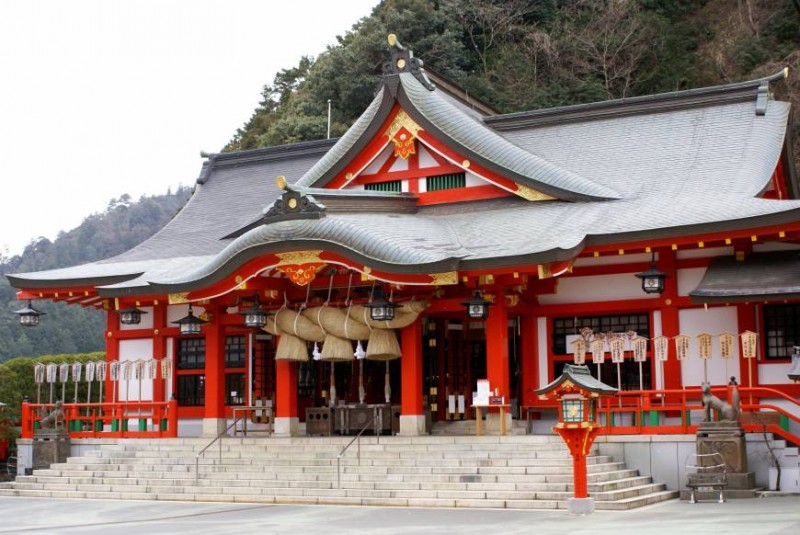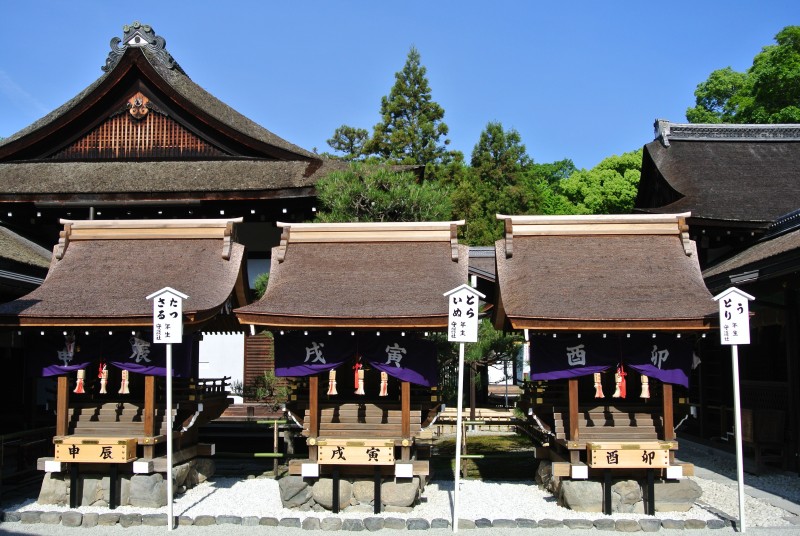
The vermilion main hall of Tsuwano’s Taikodani Inari Shrine (photo by Mandy Bartok)
Lafcadio Hearn had a remarkable instinctive understanding of Shinto, the first Westerner to get at the essence of the religion. Whereas his great contemporaries like Satow, Chamberlain and Aston were much more proficient in Japanese, they looked to written accounts or documents and were disappointed. Hearn however had a feel for what Shinto meant to the ordinary populace. Here he writes evocatively of the ancestral nature of shrine buildings…
Why certain architectural forms produce in the beholder a feeling of weirdness about which I should like to theorize some day: at present I shall venture only to say that Shinto shrines evoke such a feeling. It grows with familiarity instead of weakening; and a knowledge of popular beliefs is apt to intensify it. We have no English words by which these queer shapes can be sufficiently described – much less any language able to communicate the impression which they make. Those Shinto shrines which we loosely render by the words ‘temple’ and ‘shrine’ are really untranslatable; – I mean that the Japanese ideas attaching to them cannot be conveyed by translation. The so-called ‘august house of the Kami’ is not so much a temple, in the classic meaning of the term, as it a haunted room, a spirit-chamber, a ghost-house – ghosts of great warriors and heroes and rulers and teachers, who lived and loved and died hundreds of thousands of years ago. I fancy that to the Western mind the word ‘ghost-house’ will convey, better than such terms as ‘shrine’ and ‘temple’, some vague notion of the strange character of the Shinto miya or yashiro – containing in its perpetual dusk nothing more substantial than symbols of tokens, the latter probably of paper. Now the emptiness behind the visored form is more suggestive than anything material could possibly be…
– Writings of Lafcadio Hearn, Vol VIII, p 4-5


Here are some thoughts about Shinto which I am now so glad to share, having discovered your site, John. I have lived in the Shimogamo Shrine area for almost 40 years. I know the shrine and its environment well. I know its recent history, and this is what is so depressing and upsetting.
With the new head priest (I assume he is new) in the position of running the shrine’s daily affairs, he has not-too-slowly turned it into a company doing business, intent on raising its income, playing rock music during shinto celebrations, putting a cake shop right on the inner-shrine property, tearing down the old martial arts building (thank you) and erecting apartment buildings, forbidding bicycles from riding over the outer shrine paths, raising the celebration fees, enlarging the stalls where shrine objects are sold while also introducing more, cheap-looking items. In the neighbourhood surrounding the shrine, very many homes have small, green cloths hanging on the door knobs, in disapproval of the apartment buildings being made now.
For me, the worse offense is the use of leaf-blowers. What a travesty. Every morning the neighbourhoods around the shrine are bombarded with the machine’s deafening noise. In summer, dust is raised into the air where it is carried throughout the area. The leaves are not carried away, but only moved to the paths’ sides to rot in place. Even on rainy days, and in spring where there are no leaves falling, the leaf-blowers are at work in the mornings. This is too much. I have stopped connecting myself with Shimogamo Shrine. Its god must be very upset, or may possibly have moved away. The shrine is no longer a religious location.
The whole atmosphere of the place has changed. It is now a pseudo-commercial establishment using its age and location as an attraction for raising more money.
Shimogamo Shrine is a fake; it is religiously insincere. It is a shame for Shintoism, on a par with Nashi-no-ki Shrine for shamelessness. (I was told that Nashi shrine was kicked out of the Shrine Association, or something like that.)
Just my sounding off about this horrible phony and mountebank.
Thank you, Richard, for that. You are far more outspoken on the subject than I, though as a much longer resident of the area you have every right to bemoan the changes which you have witnessed. I’ve written several times about the incremental changes I have noticed each year, all designed to raise the tourist appeal of the shrine. This is not uncommon though, as shrines (like Buddhist temples) are increasingly feeling the financial pinch as a secular society undergoes a decrease in population. I wasn’t aware of the little green protest cloths, so thank you for pointing that out. Completely agree with you about the leaf-blowers though! Whatever would Richard Ponsonby-Fane have thought?